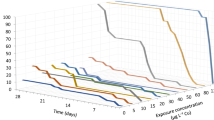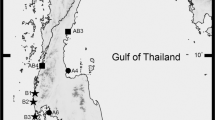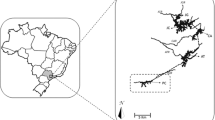Abstract
Under a low temperature condition of 12°C, accumulation of copper by the ragworm, Hediste (Nereis) diversicolor, increased at low salinity of 7.6‰ but was reduced at intermediate and high salinities of 15.25 and 30.5‰, respectively. Copper contents of the worms at low salinity and temperature ranged from 68 to 185 µg/g. Under increasing temperature of 17 and 22°C, bioavailability of copper to the worms increased irrespective of salinity gradient. The copper contents of the worm ranged from 59 to 784 µg/g dry weight. ANOVA analysis of data showed that salinity did not significantly affect accumulation of copper by the worm. Temperature significantly affected accumulation. The interaction of salinity and temperature was significant and complex, and days of exposure did not influence accumulation. Depuration of copper by the worm was independent of salinity which ranged from 510 to 15.6 µg/g. Temperature significantly affected depuration. The interaction of salinity and temperature was significant. However, individual worms neither accumulated nor depurated at the same rate.
Similar content being viewed by others
References
Bryan, G.W.: 1971, ‘The Effect of Heavy Metals Other than Mercury on Marine and Estuarine Organisms’, Proc. Royal Soc. B. Lon. 177, 389–410.
Bryan, G.W.: 1976, Some Aspects of Heavy Metal Tolerance in Aquatic Organisms, Lockwood, A.P.M. (Ed.), Cambridge University Press, pp. 7–34.
Bryan, G.W., Langston, W.J., Hummerstone, L.G. and Burt, G.R.: 1985, A Guide to the Assessment of Heavy Metal Contamination in Estuaries Using Biological Indications, Occasional Publ. No. 4, 92 pp., Mar. Biol. Ass. U.K., NERC.
Davies, O.L. (Ed.): 1942, The Design and Analysis of Industrial Experiments, 2nd ed., London Edinburgh: Oliver and Boyd.
Ellis, W.G.: 1937, ‘The Water and Electrolyte Exchange of Nereis diversicolor, Muller’, J. Exp. Biol. 14, 340–350.
Gameson, A.L.H. (Ed.): 1982, ‘The Quality of the Humber Estuary. A Review of the Results of Monitoring 1961–1981’, Published by the Yorkshire Water Authority on behalf of the Humber Estuary Committee, 88 pp.
Harrison, F.L.: 1977, ‘Biological Uptake and Effect’, in Workshop on Copper in Estuarine and Continental Water, 7–8 Dec., 1977, San Francisco, Calif. Sponsored by US Dept. of Energy, Division of Biomedical and Environmental Research, Wash., D.C., pp. 8–9.
Hart, B.T.: 1981, ‘Trace Metal Complexing Capacity of Natural Waters: A Review’, Environ. Technol. Lett. 2, 95–110.
Howard, L.S. and Brown, B.E.: 1983, ‘Natural Variations in Tissue Concentration of Copper, Zinc and Iron in the Polychaete Nereis diversicolor’, Mar. Biol. 78, 87–97.
Luoma, S.N.: 1983, ‘Bioavailability of Trace Elements to Aquatic Organisms’, Sci. Total Environ. 28, 1–22.
Ozoh, P.T.E.: 1990. ‘Volume Regulation and Accumulation of Copper in Whole and Decapitated Hediste (Nereis) diversicolor, Under Various Salinity-Copper Regimes’, Water, Air, Soil Pollut. 49 (3–4), 215–230.
Ozoh, P.T.E. and Jones, N.V.: 1990a, ‘Capacity Adaptation of Hediste (Nereis) diversicolor Embryogenesis to Salinity, Temperature and Copper’, Mar. Environ. Res. 28, 227–243.
Ozoh, P.T.E. and Jones, N.V.: 1990b, ‘The Effects of Salinity and Temperature on the Toxicity of Copper to 1 Day and 7-Day Old Larvae of Hediste (Nereis) diversicolor (O.F. Muller)’, Ecotoxicol. Environ. Saf. 19, 24–32.
Ozoh, P.T.E. and Jones, N.V.: 1990c, ‘Physiological, Ecological and Management Implications of Using Ragworm Hediste (Nereis) diversicolor as a ‘Sentinel Organism’ in Monitoring Heavy Metals in Estuaries’, in press. Ocean and Shoreline Mangt.
Phillips, D.J.H.: 1979, ‘The Common Mussel Mytilus edilus as an Indicator of Pollution by Zinc, Cadmium, Lead and Copper. 1. Effects of Environmental Variables on Up-take of Metals’, Mar. Biol. 38, 59–69.
Pirie, B., Fayi, I. and George, S.: 1985, ‘Ultrastructural Localization of Copper and Zinc in the Polychaete, Nereis diversicolor, from a Highly Contaminated Estuary’, Mar. Environ. Res. 17, 197–198.
Sprague, J.B.: 1968, ‘Promising Anti-Pollutant. Chelating Agent NTA Protects Fish from Copper and Zinc’, Nature, Lond. 200, 1345–1346.
Zamuda, C.D. and Sunda, W.G.: 1982, ‘The Effect of Physico-Chemical Speciation of Copper upon its Bioavailability to the American Oyster, Crassostrea virginica’, Ann. Rep. Beaufort Lab. to the U.S. Dept. of Energy, pp. 592–610.
Author information
Authors and Affiliations
Rights and permissions
About this article
Cite this article
Ozoh, P.T.E. The effect of salinity, temperature and time on the accumulation and depuration of copper in ragworm, Hediste (Nereis) diversicolor (O.F. Muller). Environ Monit Assess 29, 155–166 (1994). https://doi.org/10.1007/BF00546872
Received:
Revised:
Issue Date:
DOI: https://doi.org/10.1007/BF00546872




